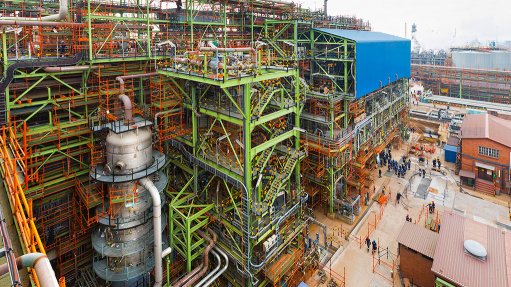
MILESTONE PHASE
Phase 1 of the Fischer-Tropsch wax expansion project saw 7 200 t of steel erected and nearly 600 km of piping used
Photo by: Sasol
Energy and chemicals group Sasol has started the second phase of its Fischer-Tropsch wax expansion project (FTWEP) in Sasolburg, Mpumalanga, following the commissioning of the first phase of the project at the end of May.
Speaking during the group’s 2015 results presentation, president and CEO David Constable noted that the second phase was expected to be commissioned during the first half of 2017.
He added that the completion of the first phase “was a significant milestone and marked another step towards expanding [Sasol’s] Southern Africa operations, as well as demonstrating [its] commitment to South Africa through ongoing industrial investment”.
Sasol has approved R13.6-billion for the project, which entails the construction of a new wax plant at the Sasol One site, in Sasolburg. Creamer Media’s Research Channel Africa reports that the new facility is expected to double the production of hard waxes and increase the production of medium waxes that are mostly used for the candle industry in South Africa.
The facility will also increase liquid paraffin production, which is used in a variety of industrial applications, such as bitumen adhesives used in road construction and printing ink.
Meanwhile, the facility’s total production of all wax products is expected to increase by about 65% once the expansion is completed.
The hard waxes, medium waxes, liquid paraffins and waxy oils, marketed through Sasol Performance Chemicals, are applied to a variety of industrial applications. The hard waxes are used in hotmelt adhesives, polyvinyl chloride processing, inks, paints and coatings, as well as asphalt applications. The medium waxes are used in the candle market and emulsions in the manufacturing of construction boards.
Phase I of the expansion resulted in 31-million hours worked, with 450 engineers and about 5 500 construction workers on site, while 7 200 t of steel was erected and nearly 600 km of piping was used.
Fischer-Tropsch Process
Sasol uses the Fischer-Tropsch process to convert natural gas, which is transported from Mozambique through pipelines, into waxes. The Fischer-Tropsch production process involves several chemical reactions where hydrogen and carbon monoxide mixtures are converted into liquid hydrocarbons in a controlled environment for consistent quality. The wax is made of saturated and straight chains of hydrocarbons.
According to online publication Chemical Technology, the new facility will be equipped with two Fischer-Tropsch units, with a “7.7-m-high, 712 t wax reactor and quench tower, [which] arrived at the site in February 2011”.
In 2014, another 344.5 t wax reactor was delivered to the expansion project.